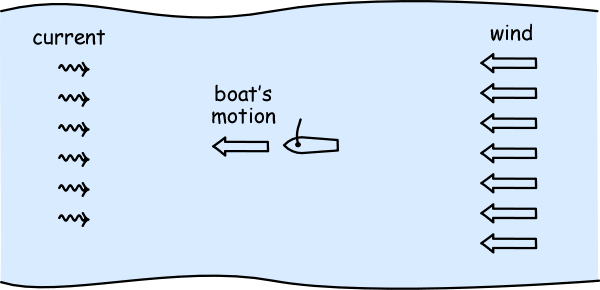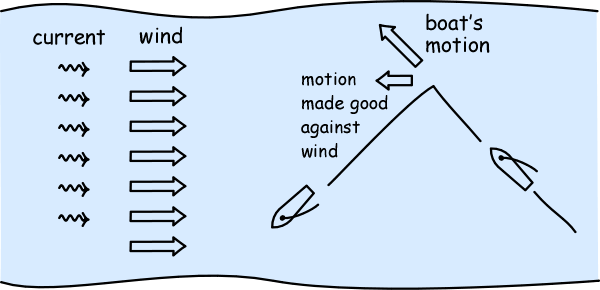
Some Useful Facts
The Easy Case: Current and Wind in Opposite Directions
The Hard Case:Current and Wind in the Same Direction
Currents on the Allegheny and Ohio Rivers
Performance of Hobie Bravo
After sailing on the rivers around Pittsburgh's Point for the summer of 2009, the answer to this question is clear: wind. Almost any wind is all it takes. That holds in all but the strongest of currents. The only time I have been unable to beat the current is when the wind drops and dies, so that I am becalmed and the current slowly and inexorably washes me back.
Once you know that this is the situation to avoid, 99% of success on the rivers just requires that you pick a suitably windy day. Currents on the rivers are less than 1 mph and most commonly a lot less than that. Winds are usually a lot more than that and almost any sailboat can use these winds to move at well over 1 mph. It is an uneven battle that the sailboat will win.
Of course, there is more to say beyond this last summary. Here are some useful things to know:
Winds may blow in all directions in the open waters of the Point. But once you are in the little valley formed by a river valley, the winds tend almost always to get redirected along the direction of the river. This can be seen in the GPS tracks linked from the main page. Once my boat is in a river valley, tacking into the wind is a symmetrical zig-zag that reveals the wind as blowing along the river.
As a result, there are only two cases that commonly arise on the river: you have the wind directly behind you; or you are sailing directly into the wind. The first of these is easy. The second is harder. Both are discussed more below.
Weather forecasts of winds from weather.com are pretty accurate. They generally get the direction of the wind right. However wind speeds at the water are more variable. Typically they are less than forecast, presumably due to obstacles on the river edges. A forecast of 12 mph migh produce winds of 6-12 mph. A forecast of 5 mph will likely produce winds of 0-5 mph. The 0 mph end is serious. It means no wind; you are becalmed. To be assured of wind, I prefer days with forecasts of 8-10 mph or more.
There are two ways I have lost wind on the river. One is that it is a relatively calm day with forecasts of, say, 5 mph. Then the variability in the wind will bring calm moments. The other is due to obstacles at the rivers edge. At the Newport Marina on the Ohio, where I put into the water, a large hill on the Southern shore can block even strong Southerly winds to produce awkward periods of calm. I have also found the stretch of the Allegheny River in front of the Convention Center to have similar problems due to the mass of the Convention Center.
Now consider the two cases:
To go upstream, the bows are just pointed directly upstream and the sail let out to "run before the wind." On this point of sail, the boat can go quite fast. In a 5 mph wind, the boat can get close to the 5 mph maximum. Since typical currents will be less than 1 mph, the boat can easily beat the current.

Returning will require the boat to tack into the wind. But now the current is aiding progress, not hindering it.
Since this is the easy case, I chose days with this configuration of wind and current for virtually all my sailing. The only days on which I had trouble were those with the harder configuration.
In order to advance against the current, the boat must now tack into the wind.

That means the boat must zig-zag across the wind sailing "close hauled"--that is as close as the boat can be brought to the direction of the wind. Examining the GPS tracks, it is clear that my little Hobie Bravo is quite able to sail at about a 45 degree angle to the wind. Consulting the data below, the boat is also commonly able to make speeds of half the wind speed when close hauled. (That half is just a rough average. Often speeds higher than this were achieved.)
Unfortunately only a portion of this speed is moving the boat directly into the wind. A rough estimate is that 50% of the speed is eventually made good into the wind. The computation is that a vector component of the boat's velocity of magnitude cos (45 degrees) = 0.71 points into the wind. However there will also be further losses when the sailboat stops during tacking turns and if the boat is not precisely close hauled.
The upshot is that I can expect my sailboat only to make something like 1/4th the speed of the wind against the current. This factor can take a toll. To imagine a worst case, if I am in a section of the river where the winds are blocked and weakened to 4 mph and there is a very strong current of 1 mph to work against, then I will be effectively stalled. But if there is more wind, I will still make headway against the current. (I would not sail in the these conditions!)
A lot depends upon the particular currents and the particular characteristics of your sailboat. Each combination will yield different outcomes. I list some more data.
Allegheny River
Flow at Dam
at Natrona on the Allegheny (upstream of Point)
Very rough conversion: 10,000 cu. ft./sec. = 0.36 mph
Monongahela
Flow at Dam
at Elizabeth on the Monongahela PLUS Flow at Dam at Youghiogheny at
Sutersville (both upstream of Point)
These are added since the Mon at the Point is
the combined flow of the Mon at Elizabeth and the Yough at
Suterville.
Very rough conversion: 10,000 cu. ft./sec. = 0.47 mph
Ohio River
Flow at Dam at Sewickley on the
Ohio (downstream of Point)
Very rough conversion: 10,000 cu. ft./sec. = 0.22 mph
For a more detailed discussion of speeds of the currents see this.
After examining the speed coded GPS tracks for my river sails this summer of 2009, it is possible to summarize the performance of the sailboat as follows.
| Date | Winds | Speed Running | Speed Close Hauled |
| July 8, 2009 GPS | 0-5 mph WNW | 1-5 mph | 0-4 mph |
| August 9, 2009 GPS | 5-10 mph SW | 0-5 mph | 1-7 mph |
| August 29, 2009 GPS | 10-12 mph WSW | 2-5 mph | 3-6 mph |
| September 6, 2009 GPS | 4-8 mph ESE | 4-6 mph | 1-5 mph |
| September 13, 2009 GPS | 4-8 mph NW | 2-5 mph | 3-6 mph |
Note that the speeds running before the wind seems to have maxima of 5-6 mph. Part of the limit comes from the poor performance of the boomless sail when running. It tends to flap and fold over. That limits the performance, as does my reefing the sail to prevent too much nuisance flapping.
The speeds achieved by the catamaran hull of the Bravo are higher than those a normal monohull of the same length (12 feet) could achieve. Displacement hulls are limited by the "hull speed," which I describe in the June 27, 2009, post. For a 12 foot monohull, displacement boat, the hull speed is 4.3 mph. I have logged the Bravo at a sustained 9.5 mph (on September 6, 2009).